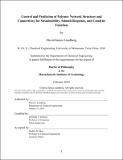Control and Prediction of Polymer Network Structure and Connectivity for Sustainability, Stimuli-Response, and Catalytic Function
Author(s)
Lundberg, David James
DownloadThesis PDF (15.01Mb)
Advisor
Johnson, Jeremiah A.
Terms of use
Metadata
Show full item recordAbstract
Polymer networks find broad application in human life because of their robustness, diverse properties, and economical production. The functions of polymer networks depend on their physical properties, which are dictated at microscopic levels by their chemical structure and connectivity. Engineers and chemists can design polymer networks with new or expanded functions by navigating within known chemistry-connectivity-property relationships, however it is often the case that new chemistries, structures, or connectivity need to be invented, explored, and understood to realize novel functions.
In this thesis, we develop and explore new chemistry-structure-connectivity relationships to design polymer networks with expanded functions related to sustainability, catalysis, and stimuli-responsiveness. In the first half, we leverage well-known supramolecular self-assembly of PdxL2x-type metal-organic cages to form robust gels. Using isomeric chemistry with distinct connectivity, we fabricate gels with either expanded Pd12L24 or compact Pd2L4 MOCs as network junctions. Homogeneous catalyst moieties can be covalently appended within the endohedral space of Pd12L24 cross-links, allowing for translation into a heterogenous support with well-defined local environment which can be reused to allow multiple rounds of catalysis. We demonstrate this strategy for alcohol oxidation reactions catalyzed by a nitroxide, and intramolecular ring closing of allenols and alkynoic acids catalyzed by a Au(I) phosphine complex. In the latter example, of catalyst colocalization within the MOC cross-link increases catalytic activity by over two orders of magnitude. Alternately, Pd2L4 structures feature a cavity which is known to bind small molecule guests. We systematically study the influence of guest binding on the physical properties of gels containing Pd2L4 cross-links and demonstrate that this feature can be used to tune bulk dynamics, and expand gel stability and assembly conditions, overcoming a fundamental challenge of this class of materials. Finally, we design materials capable of sol-gel transitions based on tunable guest binding events, enabling new modes of stimuli-responsiveness.
In the second half, we work toward the development predictions of network deconstruction enabled by cleavable comonomer additives (CCAs). While CCA inclusion can enable network deconstruction and facilitate recycling, network connectivity and material properties can be perturbed. Therefore, prediction of the critical minimum CCA loading to enable bulk network deconstruction is highly desired. We initially derive a reverse gel-point theory predicated on classic network formation theories to establish an upper bound for the critical CCA loading and allowed us to interpret the merits of the CCA approach relative to less successful strategies (e.g., addition of cleavable cross-linkers). Next, we sought to advance the accurate characterization of copolymerization for systems with reversible propagation, which is representative of the largest class of CCAs within ring-opening metathesis (ROMP) chemistry. We resolve a critical knowledge gap in the literature due to the erroneous report of copolymer equations and perceived limitation of population balance modeling to describe these systems. Using the methods developed, accurate kinetic characterization of these systems can be achieved, which is vital for the use of stochastic simulations to predict the degradation behavior of CCA-containing materials.
Date issued
2024-02Department
Massachusetts Institute of Technology. Department of Chemical EngineeringPublisher
Massachusetts Institute of Technology